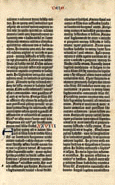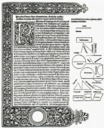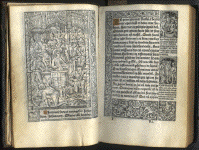
incunabulum
- A book printed during the first
fifty years of the use of
 moveable
type, from its pioneering
use by Johann Gutenberg (German, c. 1400-c. 1468) until 1501.
Gutenberg's Mazarin Bible (c. 1455) is considered the first book printed with such type.
moveable
type, from its pioneering
use by Johann Gutenberg (German, c. 1400-c. 1468) until 1501.
Gutenberg's Mazarin Bible (c. 1455) is considered the first book printed with such type. See a page from this Bible. "Incunabulum"
is sometimes used to mean an artifact
of an early period, because
it originated as a Latin word meaning "swaddling clothes"
and "cradle" -- from the time of printing's infancy.
The plural form is incunabula.
Incunabula represent the revolutionary transition from the time of hand written manuscripts and that of mechanically printed media. From the study of incunabula we gain insight into the origins of a tradition that has vastly affected the course of human culture and development, and reveals much about the life, customs, and tastes of the educated during the Renaissance. The import of incunabula is in some ways analogous to the that of such new media as you see on the Internet today.

A set
of eight woodcuts
from the 16th century depict the various parts of the printing trade
first row:
A. Making vellum
B. Making paper
C. Casting type
D. Setting type and working the press
second row:
E. Drawing illustrations
F. Cutting wood
blocks
G. Printing the woodcuts
H. Binding books.
(pr. in'cue-na"bia-lum)
Examples:

Netherlands, The Apocalypse of St. John, c. 1440,
hand-colored woodcut incunabulum, 0.262 x 0.198 m,
Louvre. See Gothic
and text.

German, Euclid's Elementa Geometriae, printed
in 1482, one page of this incunabulum, incorporating woodcut initials and illustrations, Bancroft Library, U of California, Berkeley.
Euclid (Greek, 3rd century BCE)
was a pioneer in the development of geometry.

France, Paris, Phillippe Pigouchet for Simon
Vostre, Book of Hours, 1500, incunabulum, printed
on vellum, Grolier Club,
New York City.

France, Troyes, Dance of Death, 16th century, incunabulum,
illustrated with hand-colored woodcuts,
Saxon State Library, Dresden, Germany. Based on a fourteenth-century
morality poem by an unidentifiable author, the Dance of Death
evolved into a set of illustrated
verses depicting a dialogue
between Death and people of all social ranks. The theme
was very popular in 15th and 16th century Christian Europe, reminding
the living that rank and station in life were meaningless in
the face of death. The illustrations
show representations
of ecclesiastical and secular society being carried off by Death.
The pages displayed here show the Pope, the Emperor, a cardinal,
and a king. See dance
and vanitas.
Related resources:
The Gutenberg Bible at the British Library, London.
Bodeliean Library, Oxford University's best collection of books.
Also see illuminated manuscript.
https://inform.quest/_art